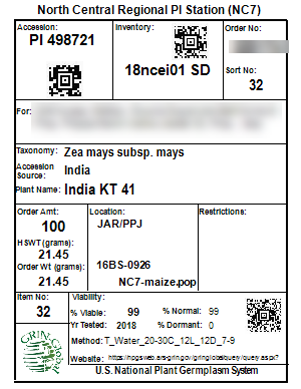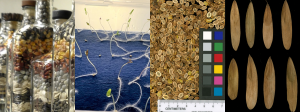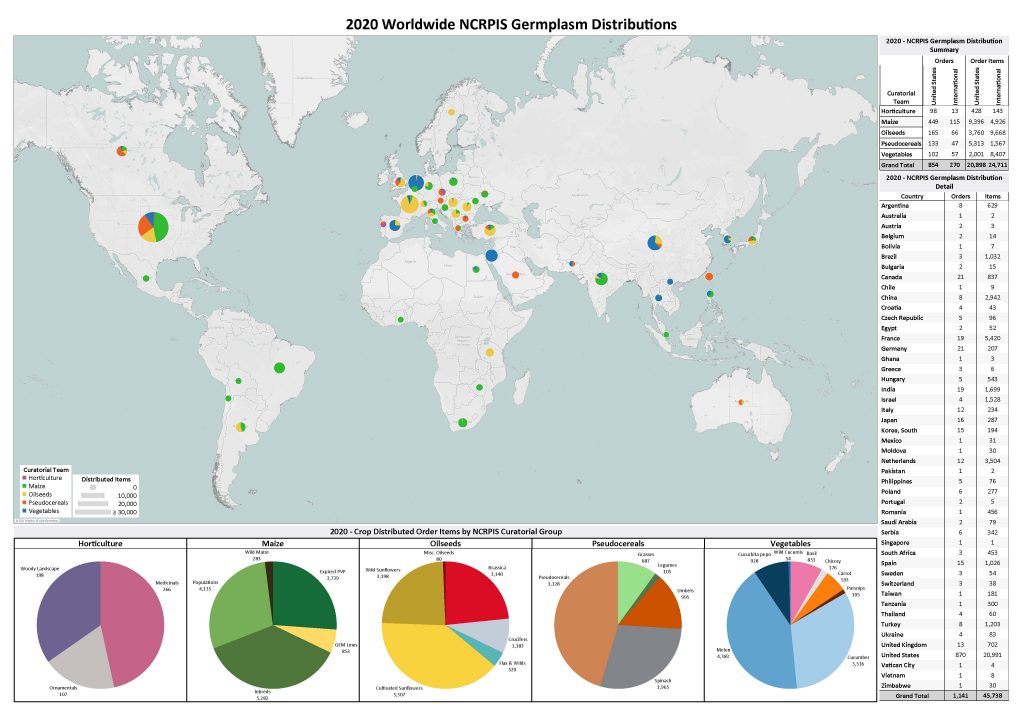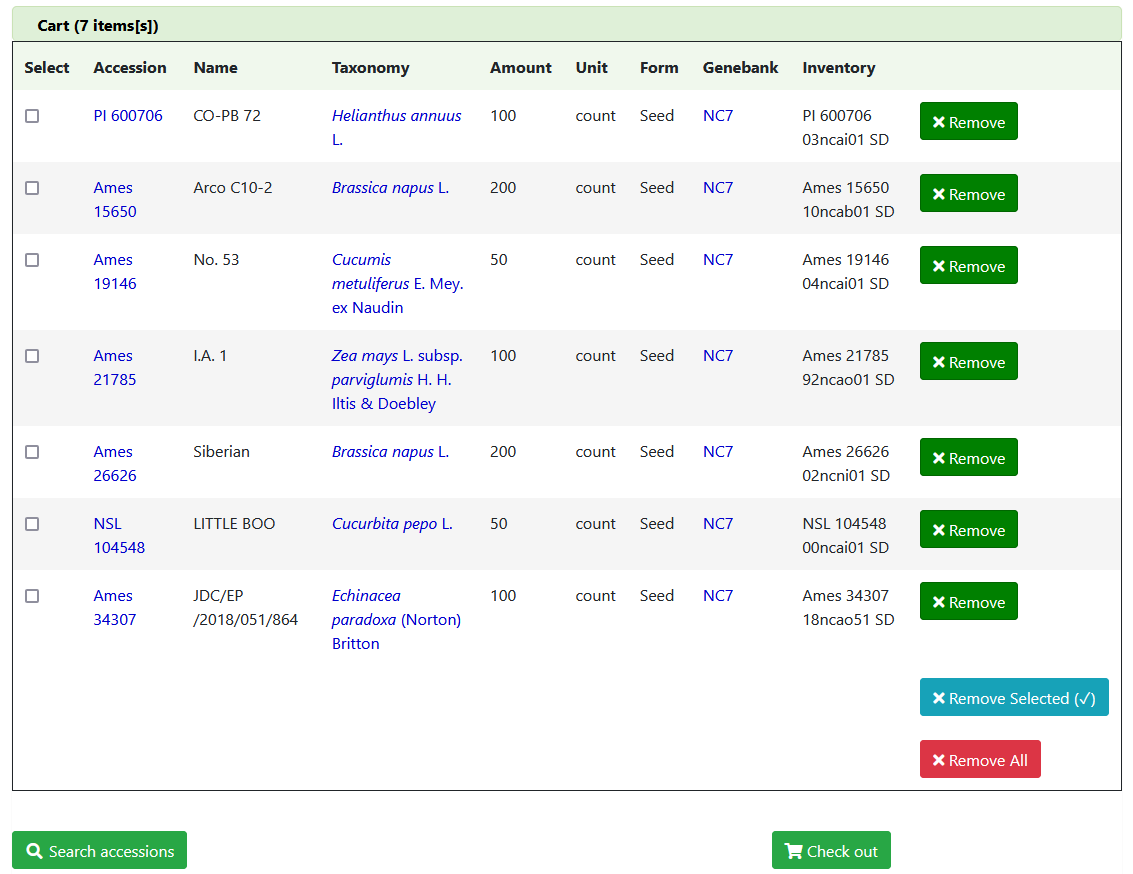Active-site Seed Storage Management and Maintenance in Ames, Iowa, a U.S. National Plant Germplasm System Location
Forrest Douglass; Lisa Burke; Candice Gardner; and Gayle M. Volk
Corresponding author: Candice.Gardner@usda.gov
The purpose of this chapter is to provide an overview of some key germplasm management and maintenance responsibilities and activities related to inventory management and maintenance of orthodox seed collections, and of germplasm distribution at the North Central Regional Plant Introduction Station (NCRPIS), in Ames, Iowa, part of the U.S. National Plant Germplasm System.
Outline
- Introduction
- What is a genebank accession?
- Storing new accession samples
- Inventory maintenance & management
- Distributing germplasm
- Summary
- References
- Additional information
- Acknowledgments
1. Introduction
In this chapter, readers will become acquainted with the origins of plant genetic resources held in genebank collections, responsibilities of the genebank, definitions of terms associated with germplasm and genebanking, and germplasm storage properties with a focus on orthodox seeds and their processes. Methods and resources used in the conservation and propagation of plant genetic resources will be discussed.
Plant genetic resources are also referred to as plant germplasm. Plant germplasm is the genetic, heritable material of a plant species or plant. Germplasm includes DNA, cells, tissues, seeds, pollen, other plant parts or whole plants. Germplasm collections include landraces of crops that have emerged over millennia of improvement by farmers, wild plants related to cultivated crops, older and current crop varieties, parental lines, specialized plant materials used to develop new varieties and hybrids, or mutant genetic stocks maintained for research. Germplasm can be preserved as dried seeds, plants growing in greenhouse, screenhouse, field plantings, or as in vitro cultures. Dried seeds of many species can be held at low temperatures in sealed containers for many years. Seeds are largely categorized as orthodox or recalcitrant for storage purposes. Orthodox seeds survive drying and/or cold storage protocols and retain their viability in storage, as opposed to recalcitrant seeds, which do not withstand drying and conventional cold storage and are more difficult to store. Plant genera that produce desiccation-intolerant seeds, or those genera that can only be propagated clonally, may be maintained in vitro as cultures of tissues or as buds, pollen, or other plant parts preserved at ultra-low temperatures. There is variability for sensitivity to these practices, and some seeds are classified as intermediate in their storage capability. Video 1 provides additional information on NCRPIS seed storage conditions.
Video 1. Ames seed storage manager Lisa Burke explains the origins and preservation of germplasm held at the NCRPIS.
2. What is a genebank Accession?
The term “accession” refers to a unique collection that represents a population (or type) of plants collected in a particular place at a particular time. Accessions can be composed of crop wild relatives, landraces, populations, varieties, inbred lines, etc. Video 2 illustrates some examples of accessions held at the NCRPIS and discusses the genebank’s responsibility to maintain an accession’s genetic profile.
Video 2. Ames seed storage manager Lisa Burke describes accession holdings and the importance of maintaining specific genetic profiles.
Because genebank accessions are used to fulfill their research objectives over long periods of time, and because researchers build upon the work of prior investigators, it is important that a genebank source reliably represents the original genetic profile. In essence, an accession becomes a type of reference standard, and multiple germplasm requestors rely on the quality of the sample to support the validity of their findings.
3. Storing New Accession Samples
When new accessions enter the collection, the intake process thoroughly documents their origins, passport and provenance information, and any other information captured as appropriate, for example habitat characteristics and properties. The GRIN-Global database detail page for a wild sunflower subspecies of Helianthus debilis collected in 2014 holds such information. By clicking on the passport tab, one can access passport information, source history, and any other accession names or identifiers associated with the accession. Once part of the genebank, an accession is maintained in perpetuity and distributed for educational and research purposes. Requests for germplasm come from around the world (Figure 1). Video 3 illustrates how newly regenerated samples are assessed prior to being stored, and considerations for sub-sampling a seed lot for purposes including distribution, retaining for future seed increase (regeneration) or sending to a backup storage location. The backup seedlots are sent to the USDA-ARS National Laboratory for Genetic Resource Preservation (NLGRP) in Ft. Collins, Colorado. The amount of seeds sent to the NLGRP varies by type of accession. For genetically homogenous accessions, 1300–1700 viable seeds are sent as backup; for genetically heterogenous or cross-pollinated species, 3000–4000 seeds are sent. For heterogenous crops, it is necessary to have more individuals to represent inherent genetic variability. To ensure quality, seed lots of domesticated species should be less than 5 years old with at least an 85% viability rate. Periodically, a sample of the seedlots are also sent to the Svalbard Global Seed Vault in Svalbard, Norway.
Figure 1. 2020 distributed order items by NCRPIS curatorial crop group.
Video 3. Ames seed storage manager Lisa Burke describes germplasm cyclical regeneration needs to maintain viability. Seeds are regrown into plants, harvested, and cross-referenced with the parent lot to ensure the continuation of their genetic line.
Optimal seed storage is facilitated by dry, cool, dark, and rodent-proof conditions, but ultimately genetics and seed properties play a large role in longevity of seeds in storage. In Ames, freezer (-20 ⁰C) storage conditions are used for original seed samples and seeds of taxa that do not store well (retain viability) at 4 ⁰C. Cold rooms maintained at 4 ⁰C and 28% RH are used for the bulk of regenerated samples. Our orthodox seed collections can be stored longer at -20 ⁰C but -20 ⁰C cold storage space is currently limited.
Seed condition when entering storage is key – clean, healthy, pathogen-free seeds of appropriate moisture content are essential to longevity of viability. Deleterious effects of seed aging occur largely due to oxidative processes (Walters et al., 2010).
4. Inventory Maintenance & Management
In addition to documentation of the original seed or plant of a new accession, care is taken to meticulously document successor generations. In addition to ensuring viability and seed purity through testing, physical measurements and digital imaging technology are used to capture physical aspects of newly regenerated seed lots and make comparisons to original seed lots prior to storage. Video 4 illustrates some of these operations.
Video 4. A topical overview on how seed inventory is managed at the North Central Regional Plant Introduction Station narrated by Ames seed storage manager Lisa Burke.
In preparation for regenerating an accession, curatorial personnel consider the genetic diversity of the original accession. Highly inbred varieties may only require a small population of plants to produce progeny representative of the original genetic profile, while highly heterogeneous populations may require fifty to hundreds of plants, depending on the species and its genomic makeup. Typically 400 plants are grown of a maize landrace accession with the goal of intermating 200 individuals and harvesting more than 100 good ears to represent the genetic diversity. An equal number of seeds is selected from each ear contribute to seedlots specifically designated for future regenerations or specialized research purposes, and the remainder of the seed is bulked for distribution and backup. Huge outcrossing plants (such as those of pumpkin) are planted with a few individuals in very large cages, pollinated using insect pollinators, and the seeds from multiple cages are combined to form a single seedlot from that season/location.
Data on seed inventories are maintained via the GRIN-Global database. An accession may have multiple inventories, reflecting a) a system identifier, such as PI number or site number, b) the system lot code, and c) possibly multiple other lot codes corresponding to regeneration seed lots. Each inventory is associated with information that curatorial personnel have captured. Internally, an inventory lot code is comprised of three parts: the accession/inventory prefix which is the PI or site identifier, accession number, and the inventory suffix that identifies uniqueness. For example, PI 550473 is the accession number for inbred maize line B73. An inventory lot code might read ‘PI 550473 98ncai01’.
Propagules are distributed externally to fulfill requests for research, education or rematriation purposes, and distributed for internal genebank use for viability or pathology testing, regeneration, genetic or phenotypic characterization, etc. As quantities are distributed, GRIN-Global tracks the inventory amounts and deducts the appropriate quantities each time an order is fulfilled through the database.
The Food and Agriculture Organization (FAO) published guidelines in 2006 for seed handling by genebanks which include recommended equilibrium moisture contents for some common crop seeds, protocols to monitor seed storage behavior, and recommendations for regeneration when germination falls below established threshold levels, generally between 72–85%.
An ideal standard viability threshold for genebank seed lots is 80%, but germination rates differ across plant taxa. While 80% may be a policy standard, biology and production conditions realistically impact a taxon’s viability threshold. The standard for acceptable carrot seed lots is 65% (and may range up to 90%), amaranth may retain up to 95% viability in good storage conditions for centuries, 75% is considered acceptable for crucifer seed lots, and the cutoff for maize is 85%. In general, the more domesticated and cultivated a plant’s history is, the more consistent germination will be, reflecting selection during domestication and breeding. Dormancy is common in undomesticated accessions and crop wild relatives. Dormant seeds are viable; determination of dormancy adds to the complexity of viability testing for genebank purposes, essential for accurately determining seed quality. Video 5 provides additional detail on inventory control, critical thresholds for germination, and distribution thresholds.
Video 5. Ames seed storage manager Lisa Burke discusses inventory maintenance considerations—viability and supply.
The reality is that survival time varies for different plant species under 4 ⁰C storage conditions; oilseed crops may retain critical viability levels from 5 to 20+ years, depending on species and especially their fatty acid composition. This contrasts with 50+ years for maize and longer for Amaranthus, 15–25 years for cultivated carrots, and a range of 20–50+ years for cucurbits. Seeds of some species (common in the Apiaceae and other families) undergo ‘after ripening’; seed viability may increase for a year or more following harvest as embryos mature. Viability retention for seeds of wild species is much more variable, and generally much shorter. We have found that some Salix (willow) species seeds lose viability in less than a year at 4 ⁰C but survive in the freezer.
Other resources that may be of interest to genebank personnel for seed quality testing include the websites of the Association of Official Seed Certifying Agencies (AOSCA) and of the International Seed Testing Association (ISTA). Commercial seed testing laboratories offer a range of services including warm and cold testing, vigor testing, and accelerated aging for seeds of primary crop species.
The GRIN-Global database is a complex system comprised of an internal database system and a public-facing interface that provides for management of all types of information associated with an accession, including viability and inventory status. When viability levels or seed quantity levels drop below established, crop-specific thresholds, an accession will be flagged as unavailable and require regeneration. The public-facing interface provides requestors with a wealth of information that enables them to select resources for their objectives and provides availability status information.
5. Distributing Germplasm
Plant germplasm requests are typically made through use of the GRIN-Global website (Figure 2). Germplasm is distributed free of charge to fulfill external requests for research, education or rematriation purposes. Standard distribution quantities vary by crop; a standard distribution quantity for maize is 100 seeds; for Amaranthus and Brassica, 200–400 seeds; for Helianthus (sunflower), 100 seeds; for Cucumis melo, 50 seeds, etc. Crop wild relatives may have much lower standard distribution amounts, as they may be challenging to maintain.
Figure 2. Screenshot of the GRIN-Global website showing the germplasm checkout page.
In Video 6, Lisa Burke demonstrates a germplasm order fulfillment process.
Video 6. Demonstration of order fulfillment by Ames seed storage manager Lisa Burke.
A seed packet’s information (Figure 3) will include basic information about the accession, its germination rate and the date of the test. It may include a URL from which the user can access recommended germination protocols. Other tag information is generally for use by genebank personnel. Researchers request NPGS accessions via the GRIN-Global database. An example of a search resulting in selections for a shopping cart is displayed in Figure 2.
 Figure 3. A seed packet label for Zea mays subspecies mays.
Figure 3. A seed packet label for Zea mays subspecies mays.
Seedlots designated for backup at the NLGRP in Fort Collins may range from 200–5,000 seeds per lot. At least 1,000 seeds are a suitable goal for backup, but if seed quantities are very limited it is crucial to backup some limited quantity of seed to avoid risk of complete loss should genebank conditions be threatened.
6. Summary
In this chapter you have learned about plant genetic resource terminology and the various responsibilities of genebank personnel with respect to germplasm conservation, maintenance, and inventory management. We briefly described some of the following:
- Types of germplasm maintained at the North Central Regional Plant Introduction Station
- How germplasm is documented upon intake to the genebank
- Assuring information accuracy related to passport, provenance, and inventory management
- Maintaining the genetic profile of accessions while regenerating (seed increase)
- Monitoring seed viability and viability standards
- Monitoring inventory holdings
- Germplasm distribution activities and use of GRIN-Global for public access
The importance of providing true-to-type germplasm to requestors, especially for research that builds on previous findings, cannot be overstated. The success of variety improvement, product development and discovery, and many basic science research efforts are dependent on access to high quality germplasm of known provenance.
7. References
Rao NK, Hanson J, Dulloo ME, Ghosh K, Nowell D, Larinde M. 2006. Manual of Seed Handling in Genebanks. Bioversity International, Rome, Italy. FAO. https://www.fao.org/3/ah803e/ah803e.pdf
Walters C, Ballesteros D, Vertucci V. 2010. Structural mechanics of seed deterioration: Standing the test of time. Plant Science 179:565-573.
8. additional information
Banner images (from left to right): Decorative seed jars (Photo credit: Forrest Douglass); Germinating seeds (Photo credit: Forrest Douglass); Polytaenia nuttallii seeds (Photo credit: Ashley Sonner); Fraxinus platypoda seeds (Photo credit: Ashley Sonner). Figure 1: 2020 distributed order items by NCRPIS curatorial crop group (Image credit: Stacey Estrada).
9. Acknowledgments
Citation: Douglass, F., Burke, L., Gardner, C., Volk, G. 2022. Seed Storage Management at the North Central Regional Plant Introduction Station. In: Volk GM (Ed.) Fundamentals of Plant Genebanking. Fort Collins, Colorado: Colorado State University. Available from: https://colostate.pressbooks.pub/fundamentalsofplantgenebanking/chapter/seed-storage-management-ncrpis/
Chapter editor: Katheryn Chen
The authors appreciate content reviews and technical support provided by Ashley Sonner.
This project was funded by the USDA-ARS and grant 2020-70003-30930 from the USDA-National Institute of Food and Agriculture-Higher Education Challenge Grant Program. USDA is an equal opportunity provider and employer. Mention of trade names or commercial products in this article is solely for the purpose of providing specific information and does not imply recommendation or endorsement by the U.S. Department of Agriculture.
Plant germplasm is the genetic, heritable material of a plant species or plant. Germplasm includes DNA, cells, tissues, seeds, pollen, other plant parts or whole plants.
A landrace is a local variety of a species of plant or animal that has distinctive characteristics arising from development and adaptation over time to localized conditions. Typically landraces are more genetically diverse than varieties derived from formal breeding practices.
A screenhouse is a structure covered with screen instead of glass or other solid covering, used for propagating plants. Screens help provide barriers to cross contamination and other damage from insects and other pests.
Seeds capable of conventional freezer storage, which is relatively inexpensive and highly accessible to many institutions
A seed that remains viable for only a short time, often 1 year or less, even under conditions that are commonly conducive to longevity. These seeds usually require colder temperatures and are relatively expensive to store.
relative humidity
An accession identifier that includes data about the seed production, including year grown, location grown, and germplasm destination (which genebank it was produced for).
A propagule is a plant part, such as a bud, sucker, or spore, that becomes detached from the rest of the plant and is capable of growing into a new plant.
Rematriation is a feminized reclamation, including the process, movement, and end goal by which Indigenous peoples reclaim their cultural (seed) heritages.
Cruciferous vegetables are from the Brassicaceae, or Cruciferae, and include broccoli, cauliflower, cabbage, kale, Brussels sprouts, collards, watercress, radishes, and bok choy.




